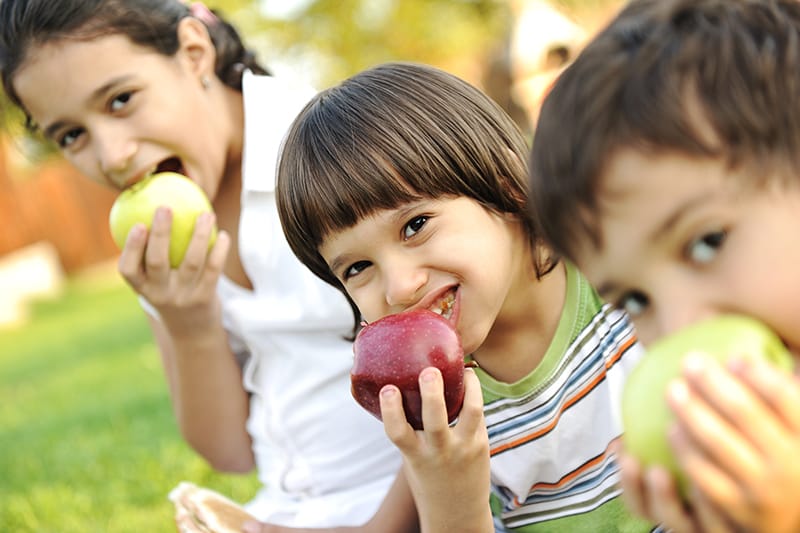You're swimming in quick and convenient snack options. But the best snacks come the way nature intended.
Posted
by The Iowa Clinic on Monday, May 21, 2018

Children need occasional calorie boosts throughout the day to provide the energy their growing bodies need. “But calories alone are not enough to support a children’s healthy physical and cognitive development – children need nutritionally dense calories,” says Dr. Jessica Greenley, a pediatrician with The Iowa Clinic.
According to Dr. Greenley, “When children eat a lot of processed foods and sugary drinks, they are more likely to develop lifelong weight issues and be unable to perform at age-appropriate levels. Poor early nutrition also sets the stage for serious health problems later in life, such as type 2 diabetes, cardiovascular diseases and certain cancers. A diet that’s rich in fruits, vegetables, whole grains, lean meat, beans and milk — in appropriate serving sizes for their age – reduces these risks.”
What are some Go, Go-Slow or No-Go snacks and beverages?
The charts below provide a quick-reference guide to the types of snacks and drinks you should serve most often (Go!), moderately (Go Slow) and almost never (No-Go).
The healthiest snacks and beverages are those that come as nature intended – unprocessed, nutrient-rich and low in sugar, fat and salt. For more interesting-but-still-healthy snack combinations, check out the kid-friendly recipes and ideas at Parents.com, USDA’s GetFreshCooking and the American Academy of Pediatrics’ HealthyChildren.org.
To learn more about childhood nutrition, BuildHealthyKids.com offers an online Kids Health Assessment, a guide to perfect serving sizes and tips for teaching your children to love healthy foods.
Teach Your Kids to be Food-Wise
To create a personalized daily nutrition plan based on your child’s age (2 or older), sex, height, weight and physical activity level, visit https://www.choosemyplate.gov/MyPlate-Daily-Checklist-input.
>Download the snack chart (PDF)
>Download the beverage chart (PDF)
GO!
Serving sizes for fruits and veggies vary. Please refer to the American Heart Association’s “What’s a Serving?” illustration.
- Fresh fruit (apples, bananas, oranges, grapes, cherries, raisins, etc.)
- Fresh veggies (carrot or celery sticks, zucchini rounds, cherry tomatoes, cucumbers, etc.)
- Whole-grain, low-sugar cereals and snacks (tortilla chips, crackers, air-popped popcorn, etc.)
- Lean proteins (meat, fish, beans, eggs)
Go Slow
Low-fat cheese and yogurts are packed with protein and calcium, and nuts are good sources of healthy fat, fiber and protein – all important to healthy bodies. But these are high in calories, so you can overdo a good thing. Watch portion sizes.
- Dried fruit (apples, apricots, peaches, pears, dates, prunes, raisins, cranberries, etc.)
- Low-fat cheeses and low-fat/low-sugar yogurts
- Nuts and nut butters
No-Go
Foods that are cooked in oil, high in sugar and/or refined flour, or processed are typically nutrient-poor and low on the satiety index, which is why they promote obesity. These foods should be limited:
- Chips
- Candy
- Baked goods, white bread and other products containing refined flour
- Ice cream
Best-bet Beverages for Growing Kids
GO!
Water is the ultimate thirst-quencher, and milk (including unsweetened nut milks) are low in sugar and high in calcium, which kids need.
- Water
- Unsweetened, unflavored sparkling water
- Low-fat milk
- Unsweetened soymilk
- Unsweetened almond milk
- Unsweetened coconut milk
Go Slow
100% juice is healthy, but too much of it provides too much natural sugar and can contribute to obesity. Appropriate daily servings are listed below.
- Orange juice
- Apple juice
- Grape juice
No-Go
Avoid drinks that contain added sugar, caffeine, high amounts of supplements intended to replenish athletes after workouts. If your child has sugary drinks, try diluting them with water.
- 10% fruit drink
- Powdered drink mix (with sugar added)
- Sport drinks, such as Gatorade
- Soda
Sources:
http://www.acaloriecounter.com/search/
https://www.foodnetwork.com/recipes/packages/recipes-for-kids/healthy-meals-for-kids/10-surprisingly-healthy-snacks-for-kids
https://kidshealth.org/en/parents/snacking.html
https://medlineplus.gov/ency/patientinstructions/000351.htm
https://kidshealth.org/en/parents/drink-healthy.html?WT.ac=p-ra
http://www.eatingwell.com/recipes/18684/healthy-kids/snacks/
https://www.webmd.com/parenting/tc/healthy-eating-in-children-problems-caused-by-poor-nutrition-topic-overview
https://www.healthykids.nsw.gov.au/kids-teens/eat-more-fruit-and-vegies
https://health.gov/dietaryguidelines/dga2000/document/build.htmn
http://www.buildhealthykids.com/servingsizes.html
Chart: Additional resources:
https://www.healthychildren.org/English/healthy-living/nutrition/Pages/Choosing-Healthy-Snacks-for-Children.aspx
https://whatscooking.fns.usda.gov/
All information offered on The Iowa Clinic website is intended to serve as general educational information only. Any content, product or service is not intended to be a substitute for professional medical advice, diagnosis or treatment. If you believe you have a medical issue, always seek the personalized advice of your physician or qualified healthcare provider.
The Iowa Clinic may provide links to outside sources for additional resources or information and is in no way responsible for the information provided by other organizations or sources. © The Iowa Clinic, 2024